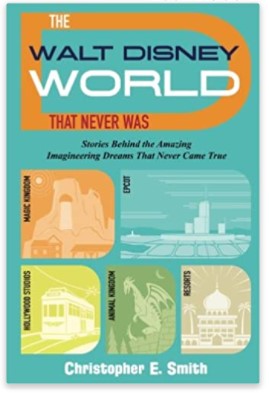Category — A Friday Visit with Jim Korkis
Fridays with Jim Korkis: Magic Music Days
Welcome back to Fridays with Jim Korkis! Jim, the dean of Disney historians, writes about Walt Disney World history every Friday on yourfirstvisit.net.
MAGIC MUSIC DAYS AT WALT DISNEY WORLD
By Jim Korkis
I would assume that many readers of this site sometime over the last thirty-five years either participated in the Magic Music Days program at Walt Disney World or enjoyed a performance by earnest and talented teenagers involved in it somewhere on the property.
Walt Disney World’s Magic Music Days Program began in 1985, followed by Disneyland in September 1987. It gives middle and high school choral, band, and other music groups the opportunity to perform at a Disney park as well as learn about musical performance from Disney professionals.
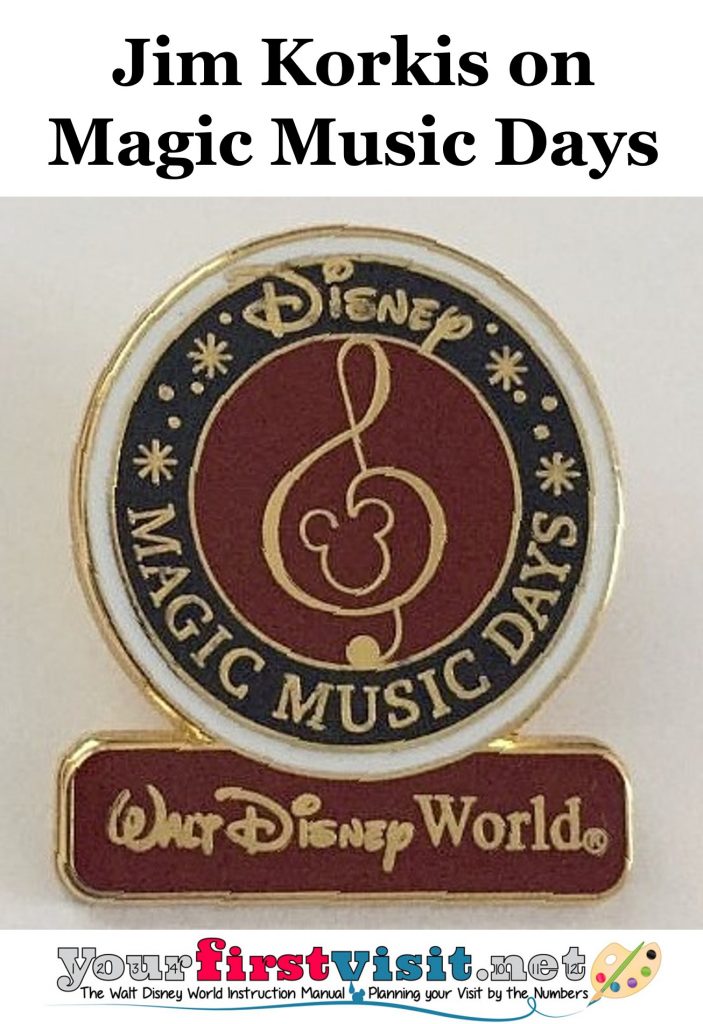
There are some differences in the Disneyland and Walt Disney World programs. At Walt Disney World, groups wishing to perform must send in a video audition and picture with their application. These are reviewed by the Magic Music Days team to ensure the group is up to Disney standards. All groups must purchase tickets through Disney Magic Music Days with a minimum 3-day theme park ticket purchase required.
Besides performing, the following workshops are offered to participants: Bands (“You’re Instrumental” and “Jazz it Up”), Choirs (“Disney Sings” and “Disney’s Show Choir Magic”) and Dance (“Disney Dancin'” and “Disney’s Broadway Magic”). According to Disney, “Professional Walt Disney World Entertainers teach at multiple workshops on Disney Property.” The workshops are typically two hours or so in length, and are an additional cost.
“It is pretty amazing to me that middle school and high school students get to experience a glimpse into the life of a professional musician, singer or dancer,” said Allen Gray, who was a program coordinator.
“In the You’re Instrumental workshop for concert and marching bands, students rehearse and record a portion of a movie soundtrack from a classic Disney animated feature film. They get to experience the intensity professional musicians feel when in the recording studio.
“Once the students see the movie and hear themselves providing the soundtrack, they get a new sense of just how much they can achieve in a short amount of time. It empowers the students to think for themselves, take accountability and perform at a new level.”
Bands may play on an outdoor stage at Disney Springs in front of the World of Disney store. At Epcot groups may perform on a stage that is encased by a temporary “shell”, this is located next to Innoventions West. The stage faces a small seating area with a control booth at the rear of the area.
For those groups that are marching, the bands perform a march down the Magic Kingdom parade route at various times that may or may not coincide with one of Disney’s actual parades. They may also march at Epcot around the World Showcase or Future World. Performances have happened at other locations around Walt Disney World as well.
In the past, participants received an exclusive Magic Music Days pin or a t-shirt with the program logo. The program operates year round and has welcomed more than 50,000 groups from six continents to the parks.
Some of the talented student performers who participated went on to successful careers including School of Rock actress Caitlin Hale, American Idol finalist Syseha Mercado and Dancing With the Stars’s Lacey Schwimmer.
* * * * *
Thanks, Jim! I can’t tell if Disney Performing Arts–the renamed version of Magic Music Days–is operating in 2022 or not. Perhaps an alert reader will let me know…And come back next Friday for more from Jim Korkis!
In the meantime, check out his books, including his new books Vault of Walt: Volume 10: Final Edition, Kungaloosh! The Mythic Jungles of Walt Disney World and Hidden Treasures of Walt Disney World Resorts: Histories, Mysteries, and Theming, much of which was first published on this site.
Follow yourfirstvisit.net on Facebook or Twitter or Pinterest!!
December 17, 2021 No Comments
Fridays with Jim Korkis: The Species Survival Program at Disney’s Animal Kingdom
Welcome back to Fridays with Jim Korkis! Jim, the dean of Disney historians, writes about Walt Disney World history every Friday on yourfirstvisit.net.
THE SPECIES SURVIVAL PROGRAM AT DISNEY’S ANIMAL KINGDOM
By Jim Korkis
Even the Covid pandemic can’t stop nature. July 2021 was a big month for babies being born to the animals at Disney’s Animal Kingdom.
A Nile Hippopotamus calf made its debut July 12 in the park’s Safi River on Kilimanjaro Safaris, joining nine other hippos in the family (also called a bloat), including mother Tuma and father Henry.
The following day, Western Lowland Gorilla mom Azizi gave birth backstage and can be seen onstage with her new child along with father Gino and the infant’s big brother Cory at Gorilla Falls Exploration Trail. The new arrival marks twelve gorillas currently in Disney’s care.
Finally, Humphrey, a Masai Giraffe calf, made his savanna debut July 29. He was born June 10, but spent time backstage bonding with mom Lily. He can be seen on Kilimanjaro Safaris, and can be recognized by the heart-shaped markings dotting his coat.
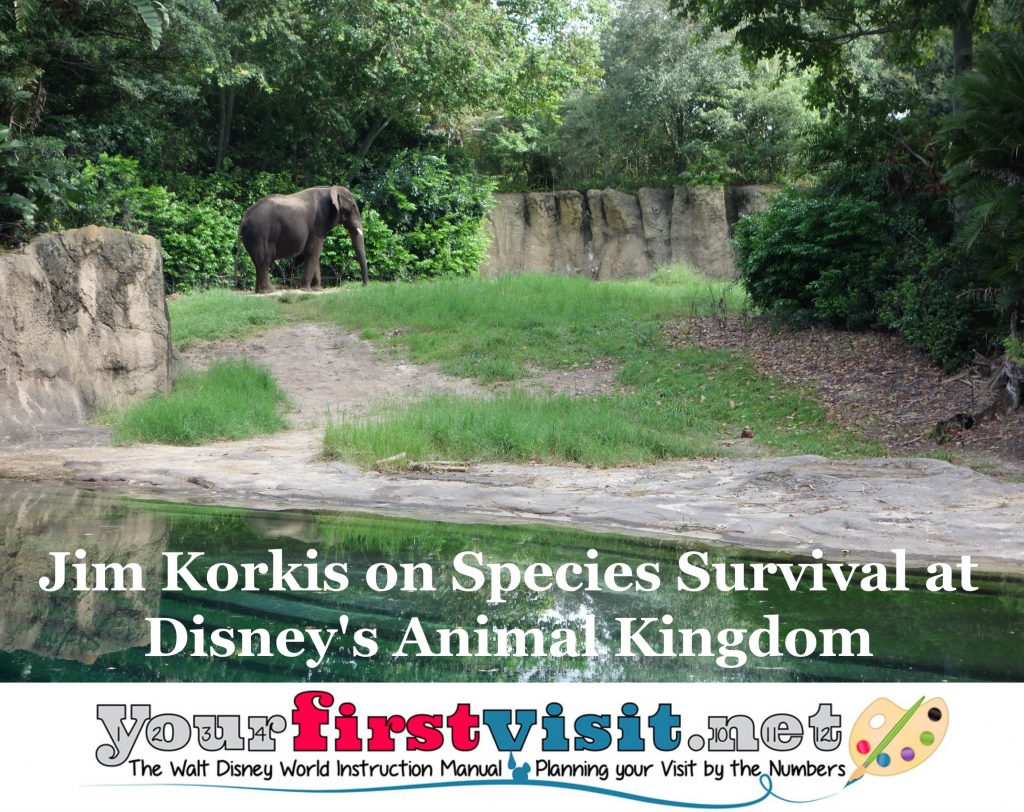
Hundreds of birds and animals have been born at Disney’s Animal Kingdom. Some were born even before the park was officially opened on April 22, 1998.
The very first animal births were a female kudu (a kind of African antelope) on October 1997 and a baby lowland gorilla in November 1997. Disney’s Animal Kingdom is part of the Association of Zoos & Aquariums (AZA) species survival programs that involve cooperative breeding and management for critical species.
Disney’s Animal Kingdom has been able to successfully breed many vulnerable animals, including black rhinos which are endangered in central and southern African as well as white rhinos which are endangered in east and southeast Africa, northeast Sudan and northeast Nigeria due to poaching for their valuable horns. Disney’s Animal Kingdom was able to breed two black rhinos and six white rhinos just in its first ten years.
Scott Terrell, director of animal and science operations for Walt Disney Parks & Resorts, said “Accredited zoos and aquariums participate in breeding programs for a variety of reasons, including helping to ensure excellent health for the animals in our care by maximizing genetic diversity and so people will be inspired to conservation action as a result of seeing live animals face-to-face when they visits places like Disney’s Animal Kingdom.”
How important is the species survival plan? In 2008 Disney’s Animal Kingdom was responsible for five of the eleven Micronesian kingfisher chicks (a very rare bird with a world population at the time of only 81) born worldwide.
Disney’s Animal Kingdom has also been responsible for the birth of Key Largo woodrats (an endangered species only found on Key Largo in Florida), and akapi (a large African mammal only found in the Ituri Forest in the Democratic Republic of Congo) among many others.
In addition, Disney’s Animal Kingdom has been responsible for the births of African elephants, a threatened species and difficult to breed. The first calf, a male named Tufani, was born May 2003, followed by Kianga, a female born in July 2004 and another female Nadirah, born December 2005.
In August 2017, two adorable Sumatran cubs named Anala and Jeda were the first Sumatran tiger cubs born at the park. Fewer than 500 Sumatran tigers are left in the wild due to threats such as habitat loss, poaching and the illegal wildlife trade. The cubs belong to Mother, Sohni, and Father, Malosi, and can be seen at the Maharajah Jungle Trek.
* * * * *
Thanks, Jim! And come back next Friday for more from Jim Korkis!
In the meantime, check out his books, including his new books Vault of Walt: Volume 10: Final Edition, Kungaloosh! The Mythic Jungles of Walt Disney World and Hidden Treasures of Walt Disney World Resorts: Histories, Mysteries, and Theming, much of which was first published on this site.
Follow yourfirstvisit.net on Facebook or Twitter or Pinterest!!
December 10, 2021 No Comments
Fridays with Jim Korkis: Rolly Crump and Epcot
Welcome back to Fridays with Jim Korkis! Jim, the dean of Disney historians, writes about Walt Disney World history every Friday on yourfirstvisit.net.
ROLLY CRUMP AT EPCOT
By Jim Korkis
Rolly Crump started at the Disney Studio in animation, and in 1959 became an Imagineer. He contributed to many of the classic attractions at Disneyland, including The Enchanted Tiki Room, the Haunted Mansion, It’s a Small World and others.
He left Disney to work on outside projects, but returned in 1976 at Marty Sklar’s request to work on Epcot. Specifically, he was involved with the Land and Wonders of Life pavilions but he also contributed to other things.
Imagineer John Hench had been laboring over a master plan for Epcot but Sklar felt that Crump might provide a new perspective. Crump didn’t care for the original proposed plan of the pavilions all looking the same from the outside. He also suggested that the monorail would drop guests off not at the front of the park but at the World Showcase Lagoon at a transportation pavilion sponsored by General Motors.
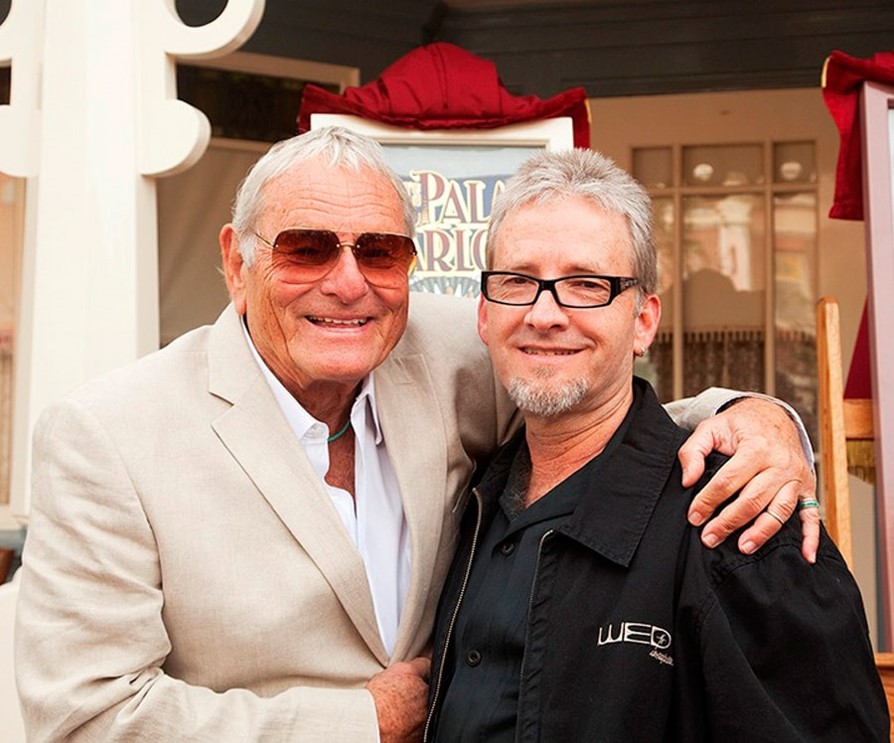
(c) Disney
All of the transportation methods to, from and around Epcot would go from that pavilion. Crump’s idea for the World Showcase was that it would be a series of islands. Guests would have to take a boat to China and from China take a carriage to India and so on. The various pavilions would be hidden from immediate sight in little valleys and hills. Fierce opposition from Hench crushed that alternate idea.
Crump also proposed having a tower in the center of Spaceship Earth that would have an observation deck for guests to see the entire park. Hench crushed that idea as well.
Crump’s idea for the Wonders of Life pavilion (then called the Life and Health pavilion) would feature the Great Midway of Life. Just like the old-time midways found at a carnival, there would be different entertainments including a Care-of-Self Carrousel which had eight health habits (sleep, diet, exercise, etc.) represented. There would have been a shooting gallery so that when a guest shot at a particular item of food like an apple or piece of cake, it would register how many calories were in it and how long it would take to burn them off.
He also proposed a dark ride for the pavilion through the human body, but unlike the eventual motion simulator Body Wars, it would be a gentle roller coaster where you would slowly work your way up to the top of the head where a brainstorm would send you spiraling back down. Besides the anatomically correct visuals surrounding the vehicle would be a narrator explaining what the guest was seeing.
Before Horizons, Crump and his team worked on a proposal for General Electric for a show hosted by an audio-animatronic Thomas Edison promoting better living through GE. Crump worked with writer and comedian Stan Freberg who suggested the building look like a box that light bulbs came in with the light bulbs sticking out of it. The pre-show would have featured cavemen doing trial and error and eventually inventing an umbrella that was called the “parasol of progress”.
When it came to redesign the Stargate Restaurant in 1994, Crump was tasked with the project. He remembered that an outside vendor had tried to interest Disney in purchasing his electric umbrellas. They were literally electric with lights on top of them. Disney didn’t care for the design or the cost but Crump loved the name.
When he pitched it CEO Michael Eisner, Eisner loved it as well and considered naming the entire building by that name instead of Innoventions. Crump did the interior mural with the neon lights and the fake rain coming down. Crump retired from Disney in 1996.
* * * * *
Thanks, Jim! Rolly Crump published a brief illustrated autobiography (with Jeff Heimbuch) in 2012—It’s Kind of a Cute Story.
And come back next Friday for more from Jim Korkis!
In the meantime, check out his books, including his new books Vault of Walt: Volume 10: Final Edition, Kungaloosh! The Mythic Jungles of Walt Disney World and Hidden Treasures of Walt Disney World Resorts: Histories, Mysteries, and Theming, much of which was first published on this site.
Follow yourfirstvisit.net on Facebook or Twitter or Pinterest!!
December 5, 2021 No Comments
Fridays with Jim Korkis: The Walt Disney World That Never Was
Welcome back to Fridays with Jim Korkis! Jim, the dean of Disney historians, writes about Walt Disney World history every Friday on yourfirstvisit.net.
YOUR PERSONAL DISNEY LIBRARY (46)
By Jim Korkis
- The Walt Disney World That Never Was by Christopher E. Smith
I have always had a particular fascination for projects that the Walt Disney Company has announced but never made. I’ve written dozens of articles about such things, as well as the book Disney Never Lands.
So I am well aware of the challenges about writing about proposed Disney theme park attractions. Often, only a piece of concept art exists, one that was designed to be highly atmospheric and dramatic to spark anticipation, but with very few specifics. Sometimes a publicity release may include merely vague hyperbole before a design is finalized.
Of course, the failure of most of these plans to be actually realized usually is the result of costs, lack of necessary technology or a change in a business agenda.
Smith proclaims the purpose of The Walt Disney World That Never Was is to provide “a collection of stories about the most significant, compelling and downright fun ideas that you won’t find in Walt Disney World today. In these stories, I will share the history and details of these wonderful ideas, why they were never developed, and where their remnants can be found in the Disney parks today.”
For the most part, he does achieve that goal. He devotes individual chapters to the “usual suspects” including Thunder Mesa, Roger Rabbit’s Hollywood, Muppet Studios, Beastly Kingdom, the original Epcot, and some never built WDW resort hotels.
In addition, he also covers some of the lesser known “lost” projects, like Dick Tracy’s Crimestoppers attraction, Mickey’s Movieland, David Copperfield’s Magic Underground, and the Alien attraction.
Unfortunately, he misses some obvious information including that Roger Rabbit’s Hollywood was the name of the area planned for Disneyland while the similar area for WDW was always labeled Roger Rabbit’s Toontown.
He also seems unaware that the reason for CEO Michael Eisner proposing an attraction based on 20th Century Fox’s Alien movie was because he had already licensed the movie for the Great Movie Ride, or that Imagineer Ward Kimball was deeply involved in creating Mickey’s Movieland.
However, nobody can know everything, and in 168 pages, Smith does provide an accurate if sometimes too brief overview of what WDW almost got. Sometimes I felt he was padding with extraneous background material because of lack of more information on the specific attraction.
I was especially pleased that he would occasionally quote from Annual Reports and news articles in the Orlando Sentinel, sometimes the only public record for the existence of many of these things. I also felt that the interior of the book was nicely laid out, so that it was easy to locate what I wanted since the book does not have an index.
Christopher E. Smith has written three other well-received books about Walt Disney World: two volumes of The Backstories and Magical Secrets of Walt Disney World and A Magical Half-Century: Stories Celebrating Walt Disney World’s First 50 Years. He has never worked for the Walt Disney Company but is a corporate attorney who with his family has been a frequent visitor to WDW for over three decades.
Smith is not a “numbers guy” so there is no emphasis on dates, measurements, costs, statistics or other such similar data. Basically, his approach to his books is that of a longtime Walt Disney World fan.
If you are also a longtime Walt Disney World fan, then I would recommend adding The Walt Disney World That Never Was to your collection and it is definitely my favorite of the Smith books.
* * * * *
Thanks, Jim! and come back next Friday for more from Jim Korkis!
In the meantime, check out his books, including his new books Vault of Walt: Volume 10: Final Edition, Kungaloosh! The Mythic Jungles of Walt Disney World and Hidden Treasures of Walt Disney World Resorts: Histories, Mysteries, and Theming, much of which was first published on this site.
Follow yourfirstvisit.net on Facebook or Twitter or Pinterest!!
November 26, 2021 No Comments
Fridays with Jim Korkis: The President Clinton Hall of Presidents Recording Session
Welcome back to Fridays with Jim Korkis! Jim, the dean of Disney historians, writes about Walt Disney World history every Friday on yourfirstvisit.net.
HOW BILL CLINTON GOT TO TALK IN THE HALL OF PRESIDENTS, PART ONE
By Jim Korkis
(For the first part of this story, see this.)
On Friday, September 3, 1993, Imagineers were in the Library room at the White House, waiting to tape President Bill Clinton for the Hall of Presidents. They had been warned not to touch anything because the room was filled with historical artifacts.
Dave Anderson, director of Television Services in charge of all media spots the president does at the White House, told the Imagineers, “Remember if you have technical problems, that’s fine but don’t try to direct the president. He likes to do one take only and he’s very good, so he usually gets it on the first pass. I’ll look at you and you tell me if there’s a problem during the first take, all right?”
President Clinton entered and warmly said “hello” to everyone and went to an adjoining room to change clothes while an entourage of aides fanned out in the Library. A Secret Service agent stood quietly, his gaze penetrating the room and quick to focus on any movement.
The president had six other things to tape that afternoon before his Disney speech. There were several re-takes on some of the earlier tapings and the president looked tenser at the end than when he first entered the room. When told he is now to tape the Hall of Presidents speech, he brightened up and told an aide, “Oh great! Have you seen this? This is a great show!”
Imagineers Rick Rothschild and Justin Segal took a moment to set the scene for the president, where his figure would be on stage, recapping what they wished to accomplish, how they would film his arm movements. The president was reminded that the narrator’s introduction is followed by a roll call and the announcement of his name and he would then command the stage.
The president stepped onto his mark on the floor. “I feel like I should sing a Disney song,” Clinton laughed as he playfully chanted softly “Heigh-Ho, Heigh-Ho” and “When You Wish Upon a Star.” Then a dead silence filled the room and he began talking very seriously in a tone unlike the previous service messages he had just recorded.
He ad-libbed several times, but the Imagineers found those changes suitable variations, and the president hit the necessary time (one minute and fifteen seconds) within a fraction of a second. “Can we do that again?” Clinton asked.
Rotschschild tells the president he doesn’t need to think about moving his arms since they already have that on tape but can concentrate entirely on his delivery of the material. When he finishes, the room bursts into spontaneous applause.
“That was a good speech…you want a job writing speeches for us at the White House?” Clinton joked and everyone laughed.
The Imagineers had several gifts for the president, including a Mickey Mouse baseball cap and making him an “Honorary Imagineer” with a WDI baseball cap. They also gave him a present for his daughter Chelsea, a Mickey and Minnie t-shirt with her name inscribed on it.
Handing the gift to a nearby aide, the pleased president said, “Please see that this gets onto her pillow by tonight.”
As the Imagineers turned to go, Clinton shook their hands and said, “That was fun! You were great! You guys did a great job!”
The Imagineers remarked on Clinton’s warmth, flexibility and imposing presence. They also noticed that during the taping of Clinton’s remarks that the president had very distinctive hand gestures. Instead of using an open hand when he spoke, he often marked his words with a closed fist, thumb-up gesture, a movement that had never before been done in audio-animatronics but that they were able to re-create.
The figure debuted in the attraction in October 1993.
* * * * *
Thanks, Jim! For the first part of this story, see this.
In the meantime, check out his books, including his new books Vault of Walt: Volume 10: Final Edition, Kungaloosh! The Mythic Jungles of Walt Disney World and Hidden Treasures of Walt Disney World Resorts: Histories, Mysteries, and Theming, much of the material for which was first published on this site.
Follow yourfirstvisit.net on Facebook or Twitter or Pinterest!!
November 19, 2021 No Comments
Fridays with Jim Korkis: How President Clinton Got to Talk in the Hall of Presidents
Welcome back to Fridays with Jim Korkis! Jim, the dean of Disney historians, writes about Walt Disney World history every Friday on yourfirstvisit.net.
HOW BILL CLINTON GOT TO TALK IN THE HALL OF PRESIDENTS, PART ONE
By Jim Korkis
The Hall of Presidents attractions re-opened on August 3, 2021, with a new audio-animatronics figure of President Joe Biden.
Breaking from recent tradition, this new version does not include a speech from the new president himself, but rather just a brief introduction and a recitation of the oath of office. Details on a table beside Biden include his signature Ray-Ban aviator style sunglasses, a vase of beautiful peach blossoms that represent his home state of Delaware, and The Penguin Book of Irish Poetry.
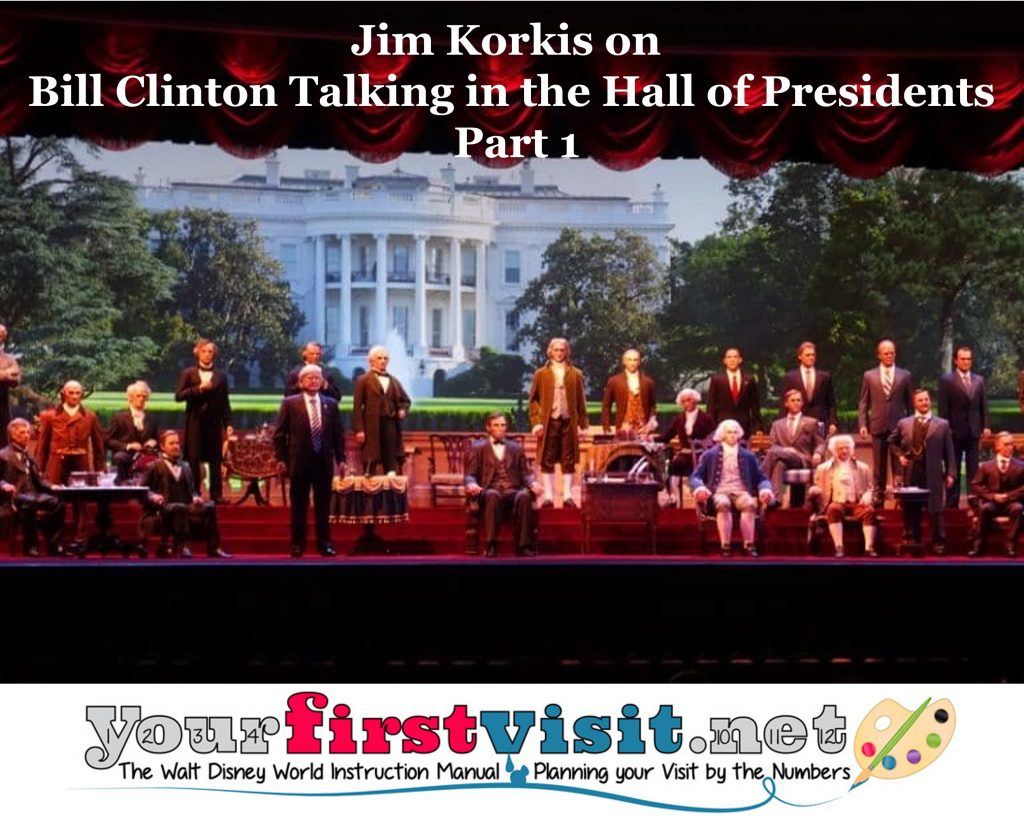
In October 1993, Imagineering added President Bill Clinton to the attraction, for the first time speaking in his own voice. This new approach was retained when George W. Bush, Barack Obama and Donald Trump became President.
In early 1992, head of Imagineering Bob Weis approached Rick Rothschild about doing something to increase attendance at the attraction. The proposal was for a multi-media theater show combining historic film re-creations with stage scenes featuring the latest technology in audio-animatronics.
CEO Michael Eisner felt that Disney could not afford such a drastic re-do at that point. He suggested doing something simpler that spotlighted President Clinton, so Imagineering came up with the idea of featuring the newest president giving a short speech in his own voice.
Richard Bates and Debbie Jardot of the Walt Disney Company’s Washington, D.C. office approached the president’s staff outlining the overall show concept, and the staff requested a script.
The script was a collaborative effort, with Eisner serving as leader and making changes and suggestions to the work of Marty Sklar, Tom Fitzgerald, Rick Rothschild and Justin Segal. The White House staff was satisfied with the result.
The president approved the idea and sent his personal information (shoe size, pants measurements, and other physical characteristics) to help construct the audio-animatronics figure that was made before the speech was recorded. However, the more difficult hurdle was finding recording time in the president’s schedule, not only because of his many commitments, but also because of shifting world events that required his attention.
As a result, Imagineers was on 24 hours notice to record for several weeks, even having WDI talent coordinator Gabrielle Reynolds searching for the best Clinton “sound alike” available, as backup. Finally, Friday, September 3, 1993 at 4:00pm was confirmed.
They had to check the acoustics in different rooms at the White House because since the figure would stand on an open stage, it was vital that the recording not sound like it was done in a small enclosed space where voices reverberate off the walls. At the last moment, one of Clinton’s speechwriter, Jonathan Prince came with changes to make the speech sound more like the president.
It was taped in the Library with two cameras, one to record the full body and the other capturing close-up facial nuances. In addition, the president was to record seven messages in a row: four related to various national organizations, one for the United Way, the Disney one, and finally one as a “kick off” for Monday Night Football telecasts.
However, the changes that Prince made and Eisner and Sklar approved by fax from California were never given to the teleprompter operator, John Mings. It had to be hurriedly typed in by hand. Mings told the Imagineers, “Actually with Clinton, I don’t have much to do, anymore. He usually carries a speech in hand and then makes a lot of changes improvising as he goes along.”
* * * * *
Thanks, Jim! and see this for Part Two: The President Clinton Recording Session.
In the meantime, check out his books, including his new books Vault of Walt: Volume 10: Final Edition, Kungaloosh! The Mythic Jungles of Walt Disney World and Hidden Treasures of Walt Disney World Resorts: Histories, Mysteries, and Theming, much of which was first published on this site.
Follow yourfirstvisit.net on Facebook or Twitter or Pinterest!!
November 12, 2021 No Comments


